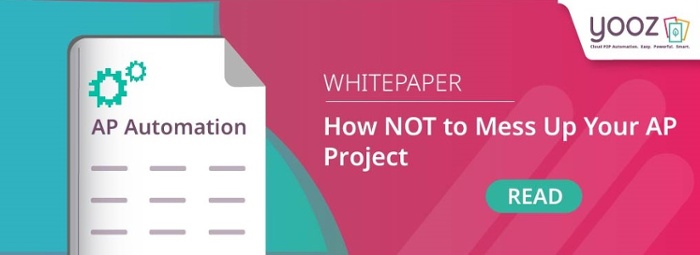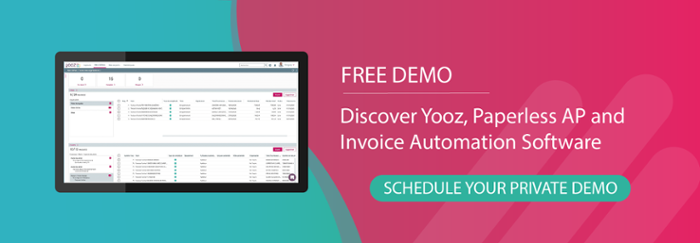Selecting the best Accounts Payable automation is more than a technical decision, it’s a strategic move towards enhancing your business’s financial operations and overall business efficiency. With AP automation software leading the charge, the emphasis is on transforming invoice and payment processes and financial reporting into a streamlined, efficient workflow. The main goal here is to navigate through the myriad of options available, pinpointing essential features that align with your company goals.
The objective is to demystify the selection process. You must be able to choose a software that meets your current needs and adapt to your future business growth. From the fundamentals of accounts payable invoice automation to deploying sophisticated software, you have to make sure you’re well-equipped to make the best decision for your enterprise.
The basics of AP automation platform
Before diving into the specifics of accounts payable automation software, it's essential to understand its foundational role in modern business finance operations.
What is AP automation software?
Accounts payable automation software transforms the way businesses handle accounts payable, making invoice processing faster and more accurate. It turns paper invoices and bills into digital files, captures data automatically, and speeds up the approval process. The key features include capturing invoices electronically, matching them automatically with purchase orders, and processing payments efficiently. It helps your business save time, reduce invoice costs and prevent mistakes.
Switching from manual, paper-based payment methods to a payable automated system provides a complete fix for the typically slow and error-prone payment and invoice processing tasks. This enables companies to manage their cash flow better and gain insights into their spending, helping them to improve their financial operations and cash management. By reducing time spent on daily payment tasks, companies can focus more on strategic growth.
Is AP automation worth it?
Absolutely. It’s essential for any business looking to enhance efficiency and accuracy. By automating invoice processing, you optimise payment timings and reduce the chance of late payments, duplicate payments and mistakes. This not only conserves resources but also provides a clear view of accounting obligations, improving cash flow management and streamlining payment operations.
AP automation systems often come with built-in compliance features that help organisations adhere to regulatory requirements and internal policies. This can reduce the risk of non-compliance penalties and audits. Automating AP processes can enhance efficiency by eliminating manual data entry tasks and reducing the time spent on invoice processing. It also helps in improving accuracy by reducing human errors associated with manual data entry and processing.

Furthermore, automation provides better visibility into the accounts payable process, allowing companies to track invoices, monitor payment statuses and generate insightful reports. This visibility enables informed decision-making and strategic planning. Besides, AP automation solutions are scalable, allowing businesses to adapt to changing business needs and accommodate growth without significant disruptions. This scalability ensures that the system remains effective and efficient as the company expands.
Accounts payable automation enables companies to shift focus from everyday tasks to more strategic goals, aiding growth and reducing the load of administrative work. With its benefits, accounts payable automation is a vital part for updating accounting operations, keeping businesses competitive and financially sound.
How does AP automation work?
It starts with digitalising the invoice process. Invoices are received from vendors through various channels such as email, mail, or electronic submission. AP automation software captures these invoices electronically, either by scanning paper invoices or by directly importing electronic invoices.
Once the invoices are captured, AP automation software extracts relevant data from the invoices, such as invoice number, date, vendor details, line items and amounts. Advanced OCR (Optical Character Recognition) technology is often used to accurately extract data from scanned documents.
The extracted data is validated against predefined rules and matched with purchase orders or contracts, if applicable. The software then routes the invoices through an automated approval workflow based on predefined rules and hierarchies. Approvers can review invoices, add comments, and approve or reject them electronically.
Approved invoices are automatically integrated with the organisation's ERP (Enterprise Resource Planning) or accounting system for further processing. Integration ensures seamless data flow between the AP automation software and other financial systems, eliminating the need for manual data entry and reducing errors.
Once invoices are approved and validated, the AP automation software facilitates payment processing. Some AP automation solutions also offer early payment discount optimisation and vendor payment portals for enhanced efficiency and collaboration.
AP automation software provides real-time visibility into the status of invoices, payment schedules, cash flow forecasts and other key metrics through customisable dashboards and reports. Businesses can gain valuable insights into their AP processes, identify bottlenecks and make data-driven decisions to optimise efficiency and reduce costs. This reduces the need for manual tasks, speeds up payment and approval processes, and ensures adherence to internal and external rules.

Key features and benefits of an AP invoice automation platform
The essential features of a good accounts payable automation software include:
- electronic invoice processing
- automated data capture
- smart matching
- workflow routing and efficient payment execution
- seamless integration with current systems
These capabilities benefit companies by reducing processing costs and time, allowing employees to concentrate on tasks that add more value. The accuracy of accounting improves, and the likelihood of invoice or payment errors decreases, enhancing accounting reporting and compliance.
AP payable automation tools strengthen relationships with vendors because of consistent and precise payments, building set up trust and reliability. A precise understanding of accounts payable invoice processes enables businesses to effectively handle cash flow management and make informed invoicing choices. It fosters growth and competitiveness in their industry.
Choosing the right AP invoice automation platform
Selecting the right AP automation software involves careful management and consideration of various factors to match the solution to your business needs.
Factors to consider when selecting an AP automation software
Choosing the appropriate payable software starts with evaluating key aspects:
-
Functionality and Features: SeekLook for invoice solutions with an extensive range of functionalities, including efficient invoice processing, payment automation, financial reporting, and comprehensive payment management.
-
Ease of Use: The invoice solution should be intuitive, allowing easy adoption and use by your finance team with no need for extensive training.
-
Scalability: Your chosen accounts payable invoice automation solution must grow with your company, supporting an increasing volume of invoices and payments.
-
Customer Support: Reliable support from the vendor is essential, particularly during setup and for ongoing challenges.
-
Compliance and Security: The accounting software must adhere to relevant regulations and offer strong data protection measures.

Price range and models of AP automation software
The pricing for AP automation tools varies widely, catering to the different requirements and sizes of businesses. These softwares are typically structured with subscription models, charging based on the amount of invoices processed or the number of users. Such flexibility is crucial for companies to adjust as they grow or as their needs change, ensuring costs are aligned with usage and avoiding unnecessary expenses.
Understanding the total cost for your business goes beyond the monthly or annual subscription fees. The initial setup, possible customisation for specific business payments, and the ability to scale with your company are important factors in your overall software investment.
Additionally, the quality of customer support can influence the platform’s value to your organisation. It’s important for every business to weigh these factors, considering both immediate needs and future growth, to choose a solution that provides lasting benefits and supports the company’s long-term goals.
Integration with existing accounting systems and ERPs
Integrating an AP automation solution with your current accounting software and Enterprise Resource Planning (ERP) systems is a critical consideration for any business. Smooth software integration is key to a hassle-free transition and keeping your operations running without interruption. When systems communicate effectively, sharing data automatically, it eliminates manual input and minimises mistakes.
It’s vital to assess how well a potential accounts payable invoice automation software can mesh with your existing ERP systems. Many offer ready-made integrations with popular accounting tools, which can simplify setting up. If you have unique system requirements or use bespoke software, the ability to use APIs for custom integration becomes crucial.
By adopting this approach, you can automate your business accounts payable process without changing your existing infrastructure. This ensures improved efficiency and accuracy without disrupting your established processes, particularly when integrating with your ERP systems.

Implementing and optimising an Accounts Payable automation platform
Implementing an AP automation software is a key move for enhancing your business accounting operations. To ensure a smooth transition and get the most out of your new invoice payment software, it's important to follow a step-by-step approach and implement proven methods.
Steps to implement AP automation software in your organisation
-
Step 1 - Needs Assessment
Start by evaluating your existing accounts payable invoice processes. Identify where inefficiencies lie and what you specifically need from an automation solution.
-
Step 2 - Vendor Selection
Pick a software that meets the requirements you’ve identified and can seamlessly integrate with your current systems.
-
Step 3 - Project Planning
Create a comprehensive plan for rolling out the new software. This should cover everything from key milestones to who handle each stage. A phased implementation might help reduce any operational disruptions.
-
Step 4 - Data Migration
Get your data ready for the new system. This may involve cleaning up current data and converting it to a format compatible with your new solution.
-
Step 5 - Training and Testing
Educate your team on how to use the new payable software. Run thorough tests to catch any issues before the software goes live.
-
Step 6 - Going Live and Monitoring
Once live, keep a close watch on the system’s performance. Be ready to solve any problems quickly to ensure smooth operations.
Following these steps will help ensure a successful implementation of your AP automation software, enabling your business to enjoy improved efficiency and accuracy in financial processing.
Best practices for optimising AP automation processes
To fully use the benefits of accounts payable invoice automation and ensure its successful implementation and long-term impact in your business, it is important to follow a set of recommended practices. These practices not only streamline the implementation process but also enhance the overall performance of your AP automation solution.
-
Continuous Training: It’s crucial to maintain an ongoing training programme for all users of the AP invoice automation software. Keeping your team informed about new solutions, features, functionalities and best practices helps them make the most of the system.
-
Process Review: Periodically assess your accounts payable invoice approval process and the configurations of your automation software. Taking a proactive approach helps identify areas where processes can be improved or simplified for better efficiency.
-
Stakeholder Feedback: Engaging actively with both users of the system and other stakeholders provides valuable insights into how the software is performing and where improvements can be made. This feedback is instrumental in fine-tuning the software to better meet the needs of its users.
-
Leverage Analytics: Advanced analytics and reporting capabilities of accounts payable automation software are invaluable for gaining deeper insights into your AP operations. By analysing trends and identifying areas for improvement, you can make data-driven decisions that enhance your workflows.

Overcoming challenges and ensuring success
Adopting new solutions often comes with its set of challenges, including resistance to change, concerns about information accuracy and the complexities of system integration. Address these challenges head-on with the following strategies:
-
Change management: Effective change management practices are key to easing the transition to a new system. Highlighting the benefits and providing ample support can help mitigate resistance and foster a positive attitude towards the new solution.
-
Quality control: Establishing rigorous quality control measures ensures the accuracy and reliability of the data within your AP invoice automation software. Regular audits and checks can prevent errors and maintain the integrity of your accounting information.
-
Technical support: A strong relationship with your vendor’s technical support team can make all the difference when navigating the initial setup of the solution and any subsequent challenges. Their expertise can help quickly resolve issues, minimising any impact on your operations.
Popular AP automation platforms in the market
Several AP automation softwares stand out in the market for their reliability, comprehensive features, and customer satisfaction. Notably, Yooz is leading the way with its AI-driven technology for capturing data from invoices. This advanced feature speeds up how swiftly invoices are processed and drastically cuts down on mistakes caused by manual input. Additionally, Yooz works well with various accounting systems, meaning it can be integrated into business operations without causing payment disruptions.
Its ease of use is a significant advantage; the software’s intuitive interface makes it simple for users to get to grips with its features, making the move to automated invoice handling smoother and more efficient.
In a nutshell, selecting the right Accounts Payable automation platform is crucial for enhancing your business's financial operations. Yooz exemplifies the potential of such tools to streamline invoice management, reduce fraud, and strengthen supplier relationships.
The right accounts payable automation solution promises improved efficiency, accuracy, and strategic accounting management, positioning your business for success in a competitive market. Don't let outdated invoice processes hold back your business. Join the hundreds of satisfied clients who've made the switch.









